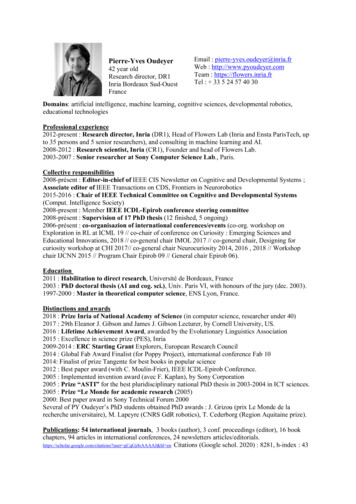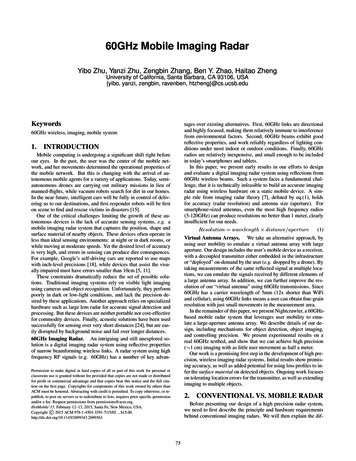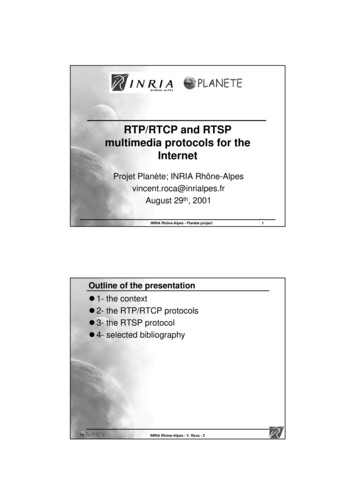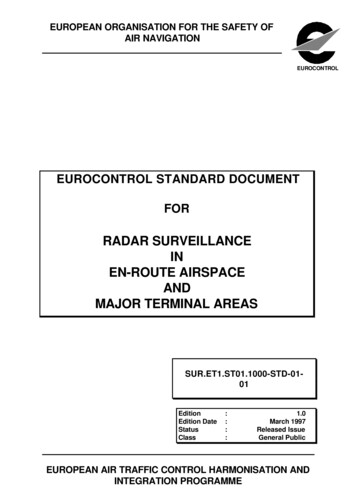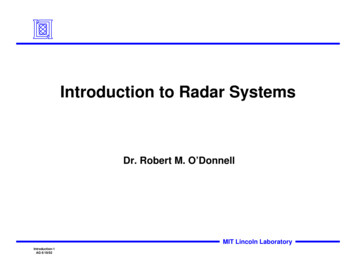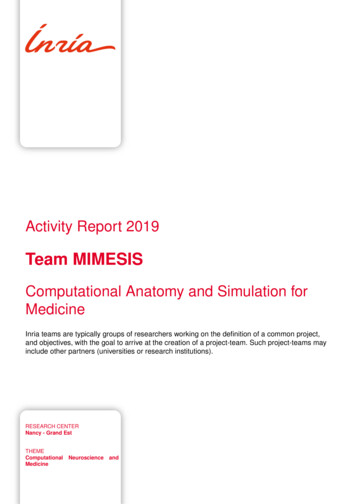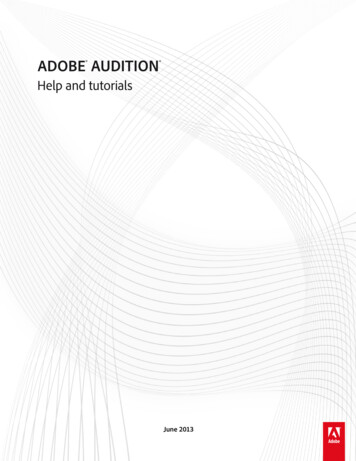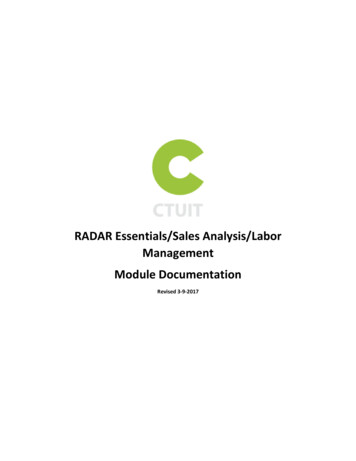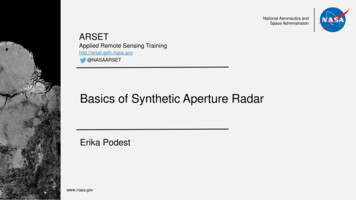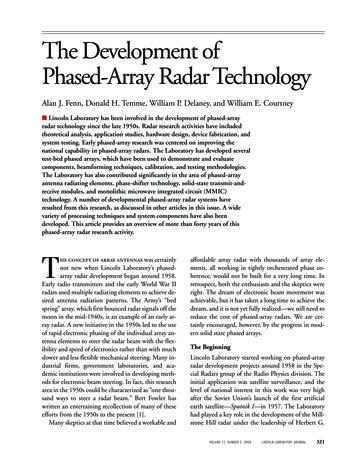
Transcription
Activity Report 2013Team CRYPTCryptanalysisRESEARCH CENTERParis - RocquencourtTHEMEAlgorithmics, Computer Algebra andCryptology
Table of contents1. Members . . . . . . . . . . . . . . . . . . . . . . . . . . . . . . . . . . . . . . . . . . . . . . . . . . . . . . . . . . . . . . . . . . . . . . . . . . . . . . . . 12. Overall Objectives . . . . . . . . . . . . . . . . . . . . . . . . . . . . . . . . . . . . . . . . . . . . . . . . . . . . . . . . . . . . . . . . . . . . . . . . 22.1. Presentation22.2. State of the Art32.3. Highlights of the Year33. Research Program . . . . . . . . . . . . . . . . . . . . . . . . . . . . . . . . . . . . . . . . . . . . . . . . . . . . . . . . . . . . . . . . . . . . . . . . 33.1. Public-Key Cryptanalysis33.1.1. Mathematical Foundations43.1.2. Lattice Algorithms43.1.3. New Assumptions43.2. Secret-Key Cryptanalysis43.2.1. Hash Functions43.2.2. Symmetric Ciphers54. Application Domains . . . . . . . . . . . . . . . . . . . . . . . . . . . . . . . . . . . . . . . . . . . . . . . . . . . . . . . . . . . . . . . . . . . . . . 54.1. Security Estimates for Cryptography54.2. Algorithmic Number Theory55. Partnerships and Cooperations . . . . . . . . . . . . . . . . . . . . . . . . . . . . . . . . . . . . . . . . . . . . . . . . . . . . . . . . . . . . 55.1. National Initiatives55.1.1. MOST’s 973 Grant55.1.2. NSFC Grant65.2. European Initiatives65.2.1. FP7 Projects65.2.2. Collaborations with Major European Organizations65.3. International Initiatives65.4. International Research Visitors66. Dissemination . . . . . . . . . . . . . . . . . . . . . . . . . . . . . . . . . . . . . . . . . . . . . . . . . . . . . . . . . . . . . . . . . . . . . . . . . . . . 66.1. Scientific Animation66.1.1. Editorial Boards66.1.2. Program Committees of International Conferences76.2. Teaching - Supervision - Juries76.2.1. Teaching76.2.2. Supervision76.2.3. Juries76.3. Popularization77. Bibliography . . . . . . . . . . . . . . . . . . . . . . . . . . . . . . . . . . . . . . . . . . . . . . . . . . . . . . . . . . . . . . . . . . . . . . . . . . . . . 7
Team CRYPTKeywords: Security, Cryptography, Algorithmic Number Theory, Computer Algebra, ComplexityCRYPT is one of the projects of the LIAMA consortium 1 . It is joint between Inria, Tsinghua University andthe Academy of Mathematics and System Sciences from the Chinese Academy of Sciences, and located atTsinghua University, Beijing, China.Creation of the Team: 2012 July 01.1. MembersResearch ScientistPhong-Quang Nguyen [Team leader, Inria, Senior Researcher, HdR]Faculty MembersXiaoyun Wang [Tsinghua, Professor, HdR]Yingpu Deng [CAS, Professor, HdR]Yanbin Pan [CAS, Associate professor]Hongbo Yu [Tsinghua, Associate professor]Keting Jia [Tsinghua, Associate professor]PhD StudentsYuanmi Chen [ENS, PhD student]Wei Wei [Tsinghua, PhD student]Dan Ding [Tsinghua, PhD student]Jianwei Li [Tsinghua, PhD student]Dianyan Xiao [Tsinghua, PhD student]Jiayang Liu [Tsinghua, PhD student]Yang Yu [Tsinghua, PhD student]Feng Zhang [CAS, PhD student]Gengran Hu [CAS, PhD student]Chang Lv [CAS, PhD student]Renzhang Liu [CAS, PhD student]Dandan Huang [CAS, PhD student]Post-Doctoral FellowJingguo Bi [Tsinghua, Post-Doctoral Fellow]Administrative AssistantsMei Zhang [LIAMA]Qi Shi [Tsinghua]1 http://liama.ia.ac.cn
2Activity Report INRIA 20132. Overall Objectives2.1. PresentationThe focus of this project is cryptanalysis, which is traditionally defined as the art of code-breaking: cryptanalysis studies the best attacks on cryptographic schemes, from a theoretical point of view (algorithm design)but also from a practical of view (implementation weaknesses, side-channel attacks). Cryptanalysis has a significant impact in the real world, because cryptographic algorithms and protocols, as well as keysizes, areselected based on the state-of-the-art in cryptanalysis. While provable security has made great advances in thepast thirty years, it is alone insufficient to select cryptographic parameters: in general, choosing parametersbased purely on security proofs leads to rather inefficient schemes. Cryptanalysis is therefore complementaryof provable security, and both are essential to our understanding of security.We consider cryptanalysis in the two worlds of cryptography: public-key cryptography (also called asymmetriccryptography) and secret-key cryptography (also called symmetric cryptography). Secret-key cryptography ismuch more efficient (and therefore more widespread) than public-key cryptography, but also less powerfulbecause it requires to share secret keys: it encompasses symmetric encryption (stream ciphers, block ciphers),message authentication codes, and hash functions. Public-key cryptography provides more functionalities suchas digital signatures, identity-based encryption and more generally functional encryption. Current public-keycryptographic techniques are based on advanced mathematics such as number theory (e.g. elliptic curves andlattices).Inside public-key cryptanalysis, we focus on lattice techniques in particular, because lattice-based cryptography has been attracting considerable interest in the past few years, due to unique features such as potentialresistance to quantum computers and new functionalities such as fully-homomorphic encryption [33] (whichallows to compute on encrypted data without requiring secret keys), noisy multi-linear maps [31] and even(indistinguishability) obfuscation [32]. These new functionalities have dramatically increased the popularityof lattice-based cryptography.Inside secret-key cryptanalysis, we are especially interested in standard hash functions and the five SHA3 finalists, due to the importance of the SHA-3 competition for a new hash function standard. We arealso interested in the security of widespread symmetric ciphers, such as the AES block cipher standard(implemented in Intel processors) and the RC4 stream cipher (widely deployed in wireless protocols).This project deals with both public-key cryptanalysis and secret-key cryptanalysis. Most of the researchersworking in cryptanalysis only study one of the two, but there seems to be more and more interaction betweenthe two fields, despite their apparent independence: For instance, coding theory techniques are now used in both secret-key cryptanalysis and public-keycryptanalysis: as an example, several standard hash functions implicitly use a linear code, and theproperties of this code are related to the security of the hash function; and public-key cryptosystemsbased on coding theory problems have been studied for more than thirty years. Similarly, Groëbner bases and related techniques are now used in both secret-key cryptanalysisand public-key cryptanalysis: algebraic attacks on stream ciphers and block ciphers are now wellestablished, and there are still a few multivariate public-key cryptosystems, more than twentyyears after the Matsumoto-Imai cryptosystem. Recently, techniques to solve systems of polynomialequations have been used in breakthrough results for solving the discrete logarithm problem overspecial finite fields and elliptic curves. As another example, time/memory tradeoffs are routinely used in both secret-key cryptanalysis andpublic-key cryptanalysis.As a side objective, this project also aims at developing European-Chinese collaboration in cryptologicresearch.
Team CRYPT32.2. State of the ArtCryptanalysis has a long history, dating back to secret writing. Until the seventies, most of the work oncryptanalysis was kept secret, but it is has now evolved from art to science, thanks to the liberalizationof cryptologic research. In general, cryptanalysis tries to answer the following question: what is the bestattack against a given cryptosystem, and how much does it cost? There is generally no definite answer tothis question, and the state-of-the-art regularly evolves over time. Cryptanalysis is a field mixing theory andpractice: while more and more advanced techniques are used, one is also concerned with very applied issuessuch as hardware/software efficiency.In the past fifteen years, a new kind of attacks have appeared in the research literature: side-channel attacks.Such attacks arguably existed long before 1996, but were not advertised in public research. In a sidechannel attack, the attacker exploits physical information which can sometimes be obtained in a concreteimplementation, such as the power consumption of the cryptographic device, or the running time of thecryptographic process, etc. The attack could be either passive or active: for instance, in a so-called fault attack,the attacker physically perturbates the cryptographic device, and depending on the type of perturbations,the faulty outputs may disclose valuable information which may leak the whole secret key. Side-channelattacks have had a huge impact in industry: many cryptographic certifications now require more or less strongresistance to side-channel attacks, and there is an annual international conference dedicated to side-channelattacks, namely the CHES conference organized by IACR.Cryptanalysis is particularly important in secret-key cryptography, due to the lack of provable securitytechniques. In public-key cryptanalysis, studying the best attack often consists in answering the followingtwo questions: What is the best algorithm to solve the computational problem (integer factoring, discrete logarithm,etc.) related to the security of the public-key cryptosystem? In particular, industry is very interestedin a practical version of this question: which keysizes are recommended? How much computationaleffort would be required exactly to break a given keysize? This question is arguably well-understoodfor integer factoring and discrete logarithm: there is more or less a consensus on what is the securitylevel provided by a given RSA modulus or ECC elliptic curve. But it is more difficult to answerfor alternative (post-quantum) problems such as lattice reduction, solving systems of polynomialequations over finite fields, and coding theory problems. Traditionally, there are more parameters forthese problems. Is there a short-cut to attack the public-key cryptosystem, rather than trying to solve the underlyingcomputational problem stated by the designer(s)? This is especially relevant when the public-keycryptosystem does not have provable security guarantees. And this question is also related to sidechannel attacks.2.3. Highlights of the YearPhong Nguyen and Xiaoyun Wang obtained a 973 grant from China’s Ministry of Science and Technology(MOST): the so-called 973 grants are China’s largest grants for fundamental research.B EST PAPER AWARD :[19] Sub-linear root detection, and new hardness results, for sparse polynomials over finite fields inISSAC ’13 - 38th international symposium on International symposium on symbolic and algebraiccomputation. J. B I , Q. C HENG , M. ROJAS .3. Research Program3.1. Public-Key CryptanalysisThis project is interested in any public-key cryptanalysis, in the broad sense.
4Activity Report INRIA 20133.1.1. Mathematical FoundationsHistorically, one useful side-effect of public-key cryptanalysis has been the introduction of advanced mathematical objects in cryptology, which were later used for cryptographic design. The most famous examples areelliptic curves (first introduced in cryptology to factor integer numbers), lattices (first introduced in cryptologyto attack knapsack cryptosystems) and pairings over elliptic curves (first introduced in cryptology to attack thediscrete logarithm problem over special elliptic curves). It is therefore interesting to develop the mathematicsof public-key cryptanalysis. In particular, we would like to deepen our understanding of lattices by studyingwell-known mathematical aspects such as packing problems, transference theorems or random lattices.3.1.2. Lattice AlgorithmsDue to the strong interest surrounding lattice-based cryptography at the moment, our main focus is to attacklattice-based cryptosystems, particularly the most efficient ones (such as NTRU), and the ones providingnew functionalities such as fully-homomorphic encryption or noisy multi-linear maps: recent cryptanalysisexamples include [3], [4] for the latter, and [6] for the former. We want to assess the concrete security levelof lattice-based cryptosystems, as has been done for cryptosystems based on integer factoring or discretelogarithms: this has been explored in [29], but needs to be developed. This requires to analyze and design thebest algorithms for solving lattice problems, either exactly or approximately. In this area, much progress hasbeen obtained the past few years (such as [30]), but we believe there is still more to come. We are working onnew lattice computational records.We are also interested in lattice-based cryptanalysis of non-lattice cryptosystems, by designing new attacksor improving old attacks. A well-known example is RSA for which the best attacks in certain settings arebased on lattice techniques, following a seminal work by Coppersmith in 1996: recently [2], we improved theefficiency of some of these attacks on RSA, and we would like to extend this kind of results.3.1.3. New AssumptionsIn the past few years, new cryptographic functionalities (such as fully-homomorphic encryption, noisymultinear maps, indistinguishability obfuscation, etc.) have appeared, many of which being based on lattices.They usually introduce new algorithmic problems whose hardness is not well-understood. It is extremelyimportant to study the hardness of these new assumptions, in order to evaluate the feasability of these newfunctionalities. Sometimes, the problem itself is not new, but the (aggressive) choices of parameters are: forinstance, several implementations of fully-homorphic encryption used well-known lattice problems like LWEor BDD but with very large parameters which have not been studied much.Currently, there are very few articles studying the concrete hardness of these new assumptions, especiallycompared to the articles using these new assumptions.3.2. Secret-Key CryptanalysisThough secret-key cryptanalysis is the oldest form of cryptanalysis, there is regular progress in this area.3.2.1. Hash FunctionsIn the past few years, the most important event has been the SHA-3 competition for a new hash functionstandard. This competition ended in 2012, with Keccak selected as the winner. We intend to study Keccak,together with the four other SHA-3 finalists (such as in [12]). New cryptanalytical techniques designed toattack SHA-3 candidates are likely to be useful to attack other schemes. For instance, this was the case for theso-called rebound attack.However, it is also interesting not to forget widespread hash functions: while it is now extremely easy togenerate new MD5 collisions, a collision for SHA-1 has yet to be found, despite the existence of theoreticalcollision attacks faster than birthday attacks. Besides, there are still very few results on the SHA-2 standardsfamily.
Team CRYPT5We may also be interested in related topics such as message authentication codes, especially those based onhash functions, which we explored in the past.3.2.2. Symmetric CiphersSymmetric ciphers are widely deployed because of their high performances: a typical case is disk encryptionand wireless communications.We intend to study widespread block ciphers, such as the AES (now implemented in Intel processors) andKasumi (used in UMTS) standards, as illustrated in recent publications [7], [9], [10] of the team. Surprisingly,new attacks [28], [27] on the AES have appeared in the past few years, such as related-key attacks and singlekey attacks. It is very important to find out if these attacks can be improved, even if they are very far frombeing practical. An interesting trend in block cipher cryptanalysis is to adapt recent attacks on hash functions:this is the reciprocal of the phenomenon of ten years ago, when Wang’s MD5 collision attack was based ondifferential cryptanalysis.Similarly to block ciphers, we intend to study widespread stream ciphers, such as RC4. The case of RC4is particularly interesting due to the extreme simplicity of this cipher, and its deployment in numerousapplications such as wireless Internet protocols. In the past few years, new attacks on RC4 based on variousbiases (such as [34]) have appeared, and several attacks on RC4 are used in WEP-attack tools.4. Application Domains4.1. Security Estimates for CryptographyAn important application of cryptanalysis is to evaluate the concrete security of a given cryptosystem, sothat key sizes and parameters are chosen appropriately. In some sense, cryptanalysis is the crash test ofcryptography. When one uses cryptography, the first thing that one does is to select parameters and keysizes: in the real world, several well-known cryptographic failures happened due to inappropriate key sizes.Cryptanalysis analyzes the best attacks known: it assesses their cost (depending on the platform) and theirperformances (such as success probability). Sometimes the exact cost of an attack cannot be evaluatedaccurately nor rigorously, but fortunately, it is often possible to give an order of magnitude, which allowsto select key sizes with a reasonable security margin.On the other hand, it must be stressed that cryptanalysis depends on the state of the art: today’s best attack maybe completely different from tomorrow’s best attack. The case of MD5 is a good reminder of this well-knownfact.4.2. Algorithmic Number TheoryAlgorithms developed for cryptanalysis have sometimes applications outside cryptanalysis, especially inalgorithmic number theory. This has happened for lattices and elliptic curves, and is not surprising, consideringthat some of the problems studied by cryptanalysis are very basic (like integer factoring), and thereforeubiquitous. Cryptanalysis motivates the search of truly-efficient algorithms, and experiments are commonin public-key cryptanalysis, which allows to really verify improvements.5. Partnerships and Cooperations5.1. National Initiatives5.1.1. MOST’s 973 GrantGrant 2013CB834205PIs Phong Nguyen and Xiaoyun WangDuration 2013-17MOST is China’s Ministry of Science and Technology.
6Activity Report INRIA 20135.1.2. NSFC GrantGrant NSFC Key Project 61133013PIs Phong Nguyen and Xiaoyun WangDuration 2013-16NSFC is the National Natural Science Foundation of China.5.2. European Initiatives5.2.1. FP7 ProjectsPhong Nguyen was leader of the Virtual Lab MAYA of FP7’s ECRYPT-II Network of Excellence, whichfinished in 2013.5.2.2. Collaborations with Major European OrganizationsCWI: Ronald Cramer’s crypto team (Netherlands). In December 2013, Cramer’s crypto teamofficially became a partner of LIAMA’s CRYPT international project: in particular, Marc Stevensexpects to do joint work on the cryptanalysis of hash functions.5.3. International Initiatives5.3.1. Inria International Labs CRYPT is an international project from LIAMA in China, located at Tsinghua University in Beijing.It is a joint project between Inria, Tsinghua University and CAS Academy of Mathematics andSystem Sciences. Phong Nguyen is the new European director of LIAMA, since December 2013: previously, he wasthe scientific coordinator of LIAMA in 2013.5.4. International Research Visitors5.4.1. Visits of International ScientistsShi Bai (Univ. of Auckland, New-Zealand)Nicolas Gama (UVSQ and CNRS, France)Ming-Deh Huang (Univ. Southern California, USA)Gaëtan Leurent (UCL, Belgium)Cheng Qi (Univ. Oklahoma, USA)Marc Stevens (CWI, Netherlands)Guangwu Xu (Univ. Wisconsin, USA)6. Dissemination6.1. Scientific Animation6.1.1. Editorial Boards Advances in Mathematics of Communications: Xiaoyun Wang Journal of Cryptology: Phong Nguyen and Xiaoyun Wang Journal of Mathematical Cryptology: Phong Nguyen Natural Science Review: Xiaoyun Wang
Team CRYPT76.1.2. Program Committees of International Conferences EUROCRYPT ’13 - May, Athens, Greece: Phong Nguyen (Program co-chair) ASIACRYPT ’13 - December, Bengaluru, India: Phong Nguyen and Xiaoyun Wang6.2. Teaching - Supervision - Juries6.2.1. TeachingPhD: Phong Nguyen, Advanced Cryptanalysis and Lattice Algorithms, 12h, CAS, China6.2.2. SupervisionPhD: Léo Ducas, Signatures fondées sur les réseaux euclidiens: attaques, analyses et optimisations,Univ. Paris 7, November 12th 2013, Phong NguyenPhD: Yuanmi Chen, Réduction de réseau et sécurité concrète du chiffrement complètement homomorphe, Univ. Paris 7, November 13th 2013, Phong NguyenPhD: Aurore Guillevic, Étudie de l’arithmétique des couplages sur les courbes algébriques pour lacryptographie, ENS, December 20th 2013, Damien Vergnaud and Phong NguyenPhD: Yupeng Jiang, CAS, Summer 2013, Yingpu Deng6.2.3. JuriesPhD: Léo Ducas, Signatures fondées sur les réseaux euclidiens: attaques, analyses et optimisations,Univ. Paris 7, November 12th 2013, Phong Nguyen (supervisor)PhD: Yuanmi Chen, Réduction de réseau et sécurité concrète du chiffrement complètement homomorphe, Univ. Paris 7, November 13th 2013, Phong Nguyen (supervisor)6.3. PopularizationPhong Nguyen gave several invited talks: [17] at the Workshop on Number Theory, Geometry and Cryptography in UK. [16] at the Workshop on Algebraic Aspects of Cryptography in Japan.7. BibliographyMajor publications by the team in recent years[1] J. B I , Q. C HENG , M. ROJAS . Sub-linear root detection, and new hardness results, for sparse polynomialsover finite fields, in "ISSAC ’13 - 38th international symposium on International symposium on symbolicand algebraic computation", Boston, United States, M. B. M ONAGAN , G. C OOPERMAN , M. G IESBRECHT(editors), ACM, June 2013, pp. 61-68 [DOI : 10.1145/2465506.2465514], http://hal.inria.fr/hal-00922224[2] J. B I , J.-S. C ORON , J.-C. FAUGÈRE , P. Q. N GUYEN , G. R ENAULT, R. Z EITOUN . Rounding and ChainingLLL: Finding Faster Small Roots of Univariate Polynomial Congruences, in "PKC 2014 - 17th IACRInternational Conference on Practice and Theory of Public-Key Cryptography", Buenos Aires, Argentina,Springer, 2014, http://hal.inria.fr/hal-00926902[3] J. B I , M. L IU , X. WANG . Cryptanalysis of a homomorphic encryption scheme from ISIT 2008, in "ISIT 2012- IEEE International Symposium on Information Theory", Cambridge, États-Unis, IEEE, July 2012, pp. 2152- 2156 [DOI : 10.1109/ISIT.2012.6283832], http://hal.inria.fr/hal-00922226
8Activity Report INRIA 2013[4] Y. C HEN , P. Q. N GUYEN . Faster Algorithms for Approximate Common Divisors: Breaking FullyHomomorphic-Encryption Challenges over the Integers, in "EUROCRYPT 2012", Cambridge, Royaume-Uni,D. P OINTCHEVAL , T. J OHANSSON (editors), Lecture Notes in Computer Science, Springer, April 2012, vol.7237, pp. 502-519 [DOI : 10.1007/978-3-642-29011-4 30], http://hal.inria.fr/hal-00864374[5] L. D UCAS , P. Q. N GUYEN . Faster Gaussian Lattice Sampling Using Lazy Floating-Point Arithmetic, in"ASIACRYPT 2012 - 18th International Conference on the Theory and Application of Cryptology andInformation Security", Beijing, Chine, X. WANG , K. S AKO (editors), Lecture Notes in Computer Science,Springer, December 2012, vol. 7658, pp. 415-432 [DOI : 10.1007/978-3-642-34961-4 26], http://hal.inria.fr/hal-00864360[6] L. D UCAS , P. Q. N GUYEN . Learning a Zonotope and More: Cryptanalysis of NTRUSign Countermeasures,in "ASIACRYPT 2012 - 18th International Conference on the Theory and Application of Cryptology andInformation Security", Beijing, Chine, X. WANG , K. S AKO (editors), Lecture Notes in Computer Science,Springer, December 2012, vol. 7658, pp. 433-450 [DOI : 10.1007/978-3-642-34961-4 27], http://hal.inria.fr/hal-00864359[7] K. J IA , L. L I , C. R ECHBERGER , J. C HEN , X. WANG . Improved Cryptanalysis of the Block Cipher KASUMI,in "SAC 2012 - 19th International Conference Selected Areas in Cryptography", Windsor, Canada, L. R.K NUDSEN , H. W U (editors), Lecture Notes in Computer Science, Springer, August 2012, vol. 7707, pp. 222233 [DOI : 10.1007/978-3-642-35999-6 15], http://hal.inria.fr/hal-00922230[8] T. J OHANSSON , P. Q. N GUYEN . , Advances in Cryptology – EUROCRYPT 2013, Lecture Notes in ComputerScience, Springer, May 2013, vol. 7881, 736 p. [DOI : 10.1007/978-3-642-38348-9], http://hal.inria.fr/hal00922221[9] L. L I , K. J IA , X. WANG . Improved Single-Key Attacks on 9-Round AES-192/256, in "FSE 2014 (21stInternational Workshop on Fast Software Encryption)", Londres, United Kingdom, Lecture Notes in ComputerScience, Springer, March 2014, http://hal.inria.fr/hal-00936032[10] Y. L IU , L. L I , D. G U , X. WANG , Z. L IU , J. C HEN , W. L I . New Observations on Impossible DifferentialCryptanalysis of Reduced-Round Camellia, in "FSE 2012 - 19th International Workshop Fast SoftwareEncryption", Washington, États-Unis, A. C ANTEAUT (editor), Lecture Notes in Computer Science, Springer,March 2012, vol. 7549 [DOI : 10.1007/978-3-642-34047-5 6], http://hal.inria.fr/hal-00922229[11] X. WANG , K. S AKO . , Advances in Cryptology - ASIACRYPT 2012, Lecture Notes in Computer Science,Springer, December 2012, vol. 7658, 780 p. [DOI : 10.1007/978-3-642-34961-4], http://hal.inria.fr/hal00922232[12] H. Y U , J. C HEN , X. WANG . The Boomerang Attacks on the Round-Reduced Skein-512, in "SAC 2012- 19th International Conference Selected Areas in Cryptography", Windsor, Canada, L. R. K NUDSEN ,H. W U (editors), Lecture Notes in Computer Science, Springer, August 2012, vol. 7707, pp. 287-303[DOI : 10.1007/978-3-642-35999-6 19], http://hal.inria.fr/hal-00922231Publications of the yearArticles in International Peer-Reviewed Journals
Team CRYPT9[13] M. L IU , X. WANG , G. X U , X. Z HENG . A note on BDD problems with λ2-gap, in "Information ProcessingLetters", 2014, vol. 114, no 1-2, pp. 9-12 [DOI : 10.1016/ J . IPL .2013.10.004], http://hal.inria.fr/hal00922234[14] A. WANG , M. C HEN , Z. WANG , X. WANG . Fault Rate Analysis: Breaking Masked AES HardwareImplementations Efficiently, in "IEEE Transactions on Circuits and Systems. Part II, Express Briefs", July2013, vol. 60-II, no 8, pp. 517-521 [DOI : 10.1109/TCSII.2013.2268379], http://hal.inria.fr/hal-00922227[15] W. W EI , C. T IAN , X. WANG . New transference theorems on lattices possessing n -unique shortest vectors, in"Discrete Mathematics", February 2014, vol. 315-316, pp. 144-155 [DOI : 10.1016/ J . DISC ted Conferences[16] P. Q. N GUYEN . Abstracting Lattice-based Cryptography, in "Workshop on Algebraic Aspects of Cryptography", Fukuoka, Japan, August 2013, http://hal.inria.fr/hal-00932567[17] P. Q. N GUYEN . Lattices and Finite Groups: Mathematics, Complexity and Cryptography, in "Workshop onNumber Theory, Geometry and Cryptography", Warwick, United Kingdom, July 2013, http://hal.inria.fr/hal00932569International Conferences with Proceedings[18] D. BAI , H. Y U , G. WANG , X. WANG . Improved Boomerang Attacks on SM3, in "ACISP 2013 - 18th Australasian Conference Information Security and Privacy", Brisbane, Australia, C. B OYD , L. S IMPSON (editors),Lecture Notes in Computer Science, Springer, July 2013, vol. 7959, pp. 251-266 [DOI : 10.1007/978-3-64239059-3 17], http://hal.inria.fr/hal-00922228[19] Best PaperJ. B I , Q. C HENG , M. ROJAS . Sub-linear root detection, and new hardness results, for sparse polynomialsover finite fields, in "ISSAC ’13 - 38th international symposium on International symposium on symbolicand algebraic computation", Boston, United States, M. B. M ONAGAN , G. C OOPERMAN , M. G IESBRECHT(editors), ACM, June 2013, pp. 61-68 [DOI : 10.1145/2465506.2465514], http://hal.inria.fr/hal-00922224.[20] J. B I , J.-S. C ORON , J.-C. FAUGÈRE , P. Q. N GUYEN , G. R ENAULT, R. Z EITOUN . Rounding and ChainingLLL: Finding Faster Small Roots of Univariate Polynomial Congruences, in "PKC 2014 - 17th IACRInternational Conference on Practice and Theory of Public-Key Cryptography", Buenos Aires, Argentina,Springer, 2014, http://hal.inria.fr/hal-00926902[21] G. H U , Y. PAN . Improvements on Reductions among DIfferent Variants SVP and CVP, in "WISA 2013 - 14thInternational Workshop on Information Security Applications", Jeju Island, Korea, Republic Of, Y. K IM , H.L EE , A. P ERRIG (editors), Lecture Notes in Computer Science, Springer, August 2013, http://hal.inria.fr/hal00932449[22] G. H U , Y. PAN , F. Z HANG . Solving Random Subset Sum Problem by l p-norm SVP Oracle, in "PKC 2014- 17th IACR International Conference on Practice and Theory of Public-Key Cryptography (2014)", BuenosAires, Argentina, Springer, March 2014, http://hal.inria.fr/hal-00936030
10Activity Report INRIA 2013[23] L. L I , K. J IA , X. WANG . Improved Single-Key Attacks on 9-Round AES-192/256, in "FSE 2014 (21stInternational Workshop on Fast Software Encryption)", Londres, United Kingdom, Lecture Notes in ComputerScience, Springer, March 2014, http://hal.inria.fr/hal-00936032[24] M. L IU , P. Q. N GUYEN . Solving BDD by Enumeration: An Update, in "CT-RSA 2013 - The Cryptographers’Track at the RSA Conference 2013", San Francisco, United States, E. DAWSON (editor), Lecture Notes inComputer Science, Springer, February 2013, vol. 7779, pp. 293-309 [DOI : 10.1007/978-3-642-360954 19], http://hal.inria.fr/hal-00864361[25] F. Z HANG , Y. PAN , G. H U . A Three-Level Sieve Algorithm for the Shortest Vector Problem, in "SAC 2013 20th International Conference on Selected Areas in Cryptography", Burnaby, Canada, T. L ANGE , K. L AUTER ,P. L ISONEK (editors), Springer, August 2013, vol. Lecture Notes in Computer Science, http://hal.inria.fr/hal00932455Books or Proceedings Editing[26] T. J OHANSSON , P. Q. N GUYEN (editors). , Advances in Cryptology – EUROCRYPT 2013, Lecture Notes inComputer Science, Springer, May 2013, vol. 7881, 736 p. [DOI : 10.1007/978-3-642-38348-9], http://hal.inria.fr/hal-00922221References in notes[27] A. B IRYUKOV, D. K HOVRATOVICH . Related-Key Cryptanalysis of the Full AES-192 and AES-256, in "Proc.ASIACRYPT ’09", Lecture Notes in Computer Science, Springer, 2009, vol
Team CRYPT Keywords: Security, Cryptography, Algorithmic Number Theory, Computer Algebra, Complex- ity CRYPT is one of the projects of the LIAMA consortium 1.It is joint between Inria, Tsinghua University and the Academy of Mathematics and System Sciences from the Chinese Academy of Sciences, and located at
